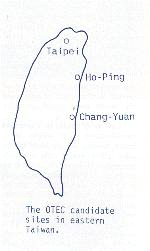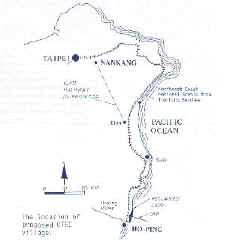It has been suggested that the 2-25 megawatt OTEC pilot plant project be scaled down because there is no economic justification for it in the ROC. This may be so. There are however compelling reasons why the ROC should assume a leadership role in a worldwide endeavor in harnessing energy from the ocean. First, to do anything less than a full-fledged operating pilot plant at the present stage of OTEC development will not contribute meaningfully to the advance of OTEC technology. The island of Taiwan is endowed with excellent conditions for OTEC application. Since ROC also has the necessary technical and financial resources, she is naturally looked upon by the world outside as a leader in advancing OTEC technology. More importantly, OTEC development will most benefit third world countries in and around the equatorial regions of the world. It will be a pity and a setback to progress if the ROC gives up this unique opportunity to be of service to the world at large, and the needy third world countries in particular.

Cost is of course an important consideration. It would be a heavy burden on anybody if the pilot plant serves only research purposes. However, it can still be made an economically viable project, if its development can be combined with that of income-generating enterprises, such as tourism. Instead of reducing the scale of the endeavor, the OTEC project should perhaps be expanded to include facilities that will generate income to help sustain the research effort. The conditions are actually quite good for this to be a success.
First, the ideal location and conditions of Hoping, the proposed plant site, as vacation spot. Its scenic, idyllic and uncluttered surroundings is among the most peaceful and relaxing places in Taiwan. Its proximity with the sea, the rivers, and the mountains, will provide recreational activities of all kinds: swimming, surfing, snorkeling, horseback-riding, canoeing, camping, trekking, etc.

The only disadvantage is its remoteness from population centers like Taipei. This may be why it has been relatively undeveloped so far. However, the Ilan-Nankang Highway, which is now being implemented, will change all that. The new highway brings Hoping to within 80 or 90 minutes' driving from Taipei, making it as accessible as the current developed coast to the north of Hoping.
The combination of an OTEC plant with the establishment of a recreational community, or village, close by has the synergic effect on both. The plant provides the village with clean, pollution-free power, and the village sustains the work of the research station with income generated from vacationers, weekend visitors, and international tourists attracted to the actual operation of an OTEC plant. It is believed that a guided tour of the plant would be among the attractions for the vacationers and tourists to come to the OTEC village at Hoping.
It will take considerably more money to put this plan into effect. First, the narrow strip of land on the ocean side of the coastal road needs to be widened by reclamation sufficiently to accommodate the village and recreational activities. Then the planning and construction of the village in conjunction with the development plan of the pilot plant. The village will be powered initially by diesel-generators. When power is later supplied by the OTEC plant, the diesel-generators will serve as stand-bys in case of power failures. All these have to be studied and developed in an enlarged feasibility study if the decision is to go ahead with the OTEC Village concept.
There is still the problem of coming up with the financing of the project until it becomes self-supporting. It is unlikely that this problem to be insurmountable, or that the initial capital, presumably to be advanced by the participating authorities involved, e.g. Taiwan Power, Tourist Bureau, etc., will be excessive. This is because the OTEC Village development can be a very attractive investment opportunity for developers, given the shortage of recreational facilities in Taiwan.
The OTEC concept is certainly an exciting and challenging one. It is also an opportunity that should not be missed. With some ingenuity in arranging for its financing, there is no reason why it should not be an economic success. The success will not be limited to that of the pilot plant alone. It will open up a whole new market for OTEC plants in areas suitable for their operation, primarily around the Pacific Rim, with ROC in the lead as a supply nation for the equipment that has been successfully proven by herself. (Philip Chow, T.Y. Lin International, U.S.A.)
